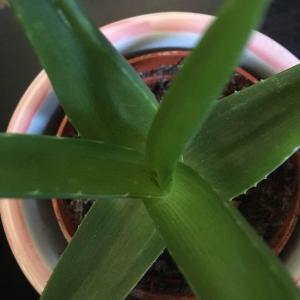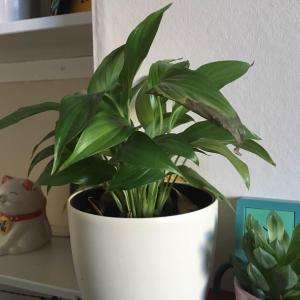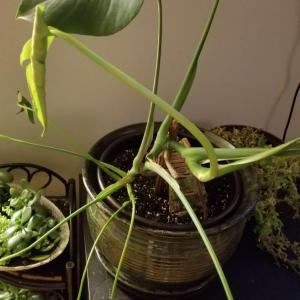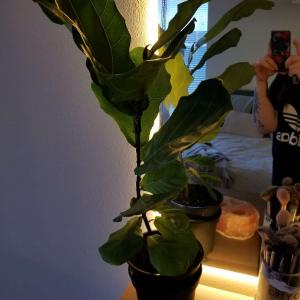成长记
cclecombe
2018年02月15日

I cant wait for this new leaf to pop out fully! It’s so exciting to see spring is finally on its way!


0
0
成长记
cclecombe
2018年02月14日

I had a bit of an accident when I built our new bed and knocked off the long vine on this plant 😩 However, I’ve spotted a new leaf on itsway out!




0
0
Lisa Stout
2018年02月14日

Common: Silver Lupine, white-leaf bush lupine, or evergreen lupine
Botanical: Lupinus albifrons
Native: California
Size: 5 ft tall x 2 ft wide
Likes: full sun, good drainage, sandy or rocky soils that are dry, but will tolerate some moisture
Notes: deer resistant, bees, hummingbirds, and butterfly attractant, fragrant flowers


Botanical: Lupinus albifrons
Native: California
Size: 5 ft tall x 2 ft wide
Likes: full sun, good drainage, sandy or rocky soils that are dry, but will tolerate some moisture
Notes: deer resistant, bees, hummingbirds, and butterfly attractant, fragrant flowers


0
0
文章
Miss Chen
2018年02月13日

Description: This plant has a vase-like rosette of large basal leaves that are spade-shaped (cordate). Each leaf has a thick sandpapery texture, particularly on the underside, and is up to 18" long and 12" wide. On young leaves, the upper surface is relatively hairless and shiny, while older leaves become dull and rough. The lower surface is light green and pubescent. The leaf margins are coarsely serrated or dentate. The petioles are about 6" long, rather narrow and wiry, and light green or brown. The overall appearance is similar to a rhubarb plant, except the petioles are more slender. A naked flowering stalk emerges from the base of the plant, ranging in height from 3' to 10' in height. This stalk is green or red, and largely hairless. The upper part of the stalk divides gracefully into a panicle of yellow composite flowers and spherical green buds. Each compound flower is about 2-3" across, and consists of 15-30 ray florets with rather pointed tips surrounding numerous disk florets. There is no noticeable floral scent. The blooming period usually occurs from late summer to early fall, and lasts about a month for an individual plant. Prairie Dock usually blooms later than other Silphium spp. It has a stout taproot that can penetrate the soil to about 12' deep, and may form offsets only a short distance away from the mother plant. The rather light, flattened achenes can be carried several feet by the wind; they are without tufts of hair.

Cultivation: The preference is full sun, a deep loamy soil, and moist to slightly dry conditions. Rocky or gravelly soil is tolerated. Drought tolerance is very good. Prairie Dock is rather slow to develop, but very reliable and nearly indestructible when mature. Patches of brown may develop when the leaves are damaged by drought, windstorms, or passing animals. It is a long-lived plant.
Range & Habitat: The native Prairie Dock occurs in most of Illinois, except for a few counties in the south and NW (see Distribution Map). It is a common plant. Habitats include moist to dry black soil prairies, gravel prairies, shrub prairies, hill prairies, savannas, seeps, limestone glades, and prairie remnants along roadsides and railroads. The exceptional height of the flowering stalk is probably useful in keeping the flowers above the taller grasses, such as Andropogon gerardii (Big Bluestem). Recovery from occasional wildfires is very good.
Panicles of Flowerheads
Faunal Associations: The composite flowers attract long-tongued bees primarily, including honeybees, bumblebees, and Miner bees. Other flower visitors include Halictine bees, bee flies, and the Ruby-Throated Hummingbird. The grubs of Okanagana balli (Prairie Cicada) feed on the large taproot; this is an uncommon prairie insect that emerges during mid-summer. Both the larvae and adults of the Silphium Beetle (Rynchites sp.) feed on the flowerheads and stems of this and other Silphium spp. The larvae of Antistrophus rufus and Antistrophus minor (Gall Wasp spp.) feed on the flowering stem of Prairie Dock, forming invisible galls. The larvae of these species attract the hyperparasitic wasp Eurytoma lutea, whose larvae feed on these gall-formers. The larvae of Mordellistena aethiops (Tumbling Flower Beetle sp.) also feed within the stem, while the adults may feed on the flowerheads. The oligolectic Iowana frisoni (Aphid sp.) sucks juices from the flowering stem. Goldfinches eat the seeds, and may help to disperse them. Large mammalian herbivores, such as cattle and the American Bison, readily eat the foliage and stems of Prairie Dock; however, the coarse sandpapery leaves of mature plants are not attractive to the Cottontail Rabbit, which prefers vegetation that is shorter and more tender.

Photographic Location: The photograph of the flowerhead close-up was taken at Meadowbrook Park in Urbana, the photograph of the panicles of flowerheads was taken along a railroad in Champaign, while the photograph of the basal leaves was taken at Dave Monk's postage stamp prairie in the latter city. Both Urbana and Champaign are in Illinois.
Comments: This is a typical plant of mesic black soil prairies that competes successfully with tall prairie grasses. It has an impressive and unusual appearance, like something out of the Stone Age when Columbian mastodons and other megafauna inhabited the prairies of North America.

Cultivation: The preference is full sun, a deep loamy soil, and moist to slightly dry conditions. Rocky or gravelly soil is tolerated. Drought tolerance is very good. Prairie Dock is rather slow to develop, but very reliable and nearly indestructible when mature. Patches of brown may develop when the leaves are damaged by drought, windstorms, or passing animals. It is a long-lived plant.
Range & Habitat: The native Prairie Dock occurs in most of Illinois, except for a few counties in the south and NW (see Distribution Map). It is a common plant. Habitats include moist to dry black soil prairies, gravel prairies, shrub prairies, hill prairies, savannas, seeps, limestone glades, and prairie remnants along roadsides and railroads. The exceptional height of the flowering stalk is probably useful in keeping the flowers above the taller grasses, such as Andropogon gerardii (Big Bluestem). Recovery from occasional wildfires is very good.
Panicles of Flowerheads
Faunal Associations: The composite flowers attract long-tongued bees primarily, including honeybees, bumblebees, and Miner bees. Other flower visitors include Halictine bees, bee flies, and the Ruby-Throated Hummingbird. The grubs of Okanagana balli (Prairie Cicada) feed on the large taproot; this is an uncommon prairie insect that emerges during mid-summer. Both the larvae and adults of the Silphium Beetle (Rynchites sp.) feed on the flowerheads and stems of this and other Silphium spp. The larvae of Antistrophus rufus and Antistrophus minor (Gall Wasp spp.) feed on the flowering stem of Prairie Dock, forming invisible galls. The larvae of these species attract the hyperparasitic wasp Eurytoma lutea, whose larvae feed on these gall-formers. The larvae of Mordellistena aethiops (Tumbling Flower Beetle sp.) also feed within the stem, while the adults may feed on the flowerheads. The oligolectic Iowana frisoni (Aphid sp.) sucks juices from the flowering stem. Goldfinches eat the seeds, and may help to disperse them. Large mammalian herbivores, such as cattle and the American Bison, readily eat the foliage and stems of Prairie Dock; however, the coarse sandpapery leaves of mature plants are not attractive to the Cottontail Rabbit, which prefers vegetation that is shorter and more tender.

Photographic Location: The photograph of the flowerhead close-up was taken at Meadowbrook Park in Urbana, the photograph of the panicles of flowerheads was taken along a railroad in Champaign, while the photograph of the basal leaves was taken at Dave Monk's postage stamp prairie in the latter city. Both Urbana and Champaign are in Illinois.
Comments: This is a typical plant of mesic black soil prairies that competes successfully with tall prairie grasses. It has an impressive and unusual appearance, like something out of the Stone Age when Columbian mastodons and other megafauna inhabited the prairies of North America.
0
0
文章
Miss Chen
2018年02月09日

Description: This perennial herbaceous plant is 1-3' tall, branching frequently to create a bushy effect. The slender stems are hairless. The slender opposite leaves are up to 3" long and ¼" across. Each leaf is sessile, linear, and hairless, with a prominent central vein and smooth margins.

The upper stems terminate in small flat heads of flowers. The short tubular flowers are white, often with scattered purple dots, and individually about ¼" long. The corolla is divided into an upper lip and a lower lip with three lobes. The reproductive structures of each flower are white, except that the anthers are purple. The calyx is divided into several slender green lobes. The blooming period is early to mid-summer, and lasts about 1–1½ months. There is no floral scent, although the foliage has a mild mint scent and somewhat stronger minty taste. The small dark seeds are without tufts of hairs, but are small enough to be dispersed by gusts of wind. The root system consists of a taproot and rhizomes. Slender Mountain Mint can spread vegetatively, forming colonies of closely bunched plants.
Cultivation: The preference is full sun and moist to slightly dry conditions. This plant often grows in rich loam, as well as soil containing rocky or gravelly material. Foliar disease is less troublesome for this mint species than many others. The leaves may assume a yellowish appearance during a major drought. This is an easy plant to grow.

Range & Habitat: The native Slender Mountain Mint occurs occasionally in every county of southern and central Illinois, but is less common and more sporadic in northern Illinois (see Distribution Map). Habitats include moist to slightly dry black soil prairies, moist meadows and gravelly areas along rivers, openings in woodlands, moist thickets, acid gravel seeps, limestone glades, and abandoned fields.
Faunal Associations: The flowers are very attractive to many kinds of insects, including long-tongued bees, short-tongued bees, wasps, flies, butterflies, skippers, beetles, and plant bugs. These insects usually seek nectar. Among the wasps, are such visitors as Thread-Waisted wasps, Bee Wolves (Philanthus spp.), Scoliid wasps, Tiphiid wasps, Sand wasps, Spider wasps, and Eumenine wasps. Flies visitors include Soldier flies, Syrphid flies, Mydas flies, bee flies, Thick-Headed flies, and Tachinid flies. The seeds are too small to be of much interest to birds. Mammalian herbivores usually don't browse on this plant because of the minty taste; the foliage may contain anti-bacterial substances that disrupt the digestive process of herbivores.
Photographic Location: The photographs were taken at Meadowbrook Park in Urbana, Illinois.
Comments: This plant has a delicate, somewhat airy appearance. Slender Mountain Mint closely resembles Pycnanthemum virginianum (Common Mountain Mint), except that the former has hairless stems and leaves that never exceed ¼" across. Common Mountain Mint, on the other hand, has lines of white hairs on its stems, and some of the larger leaves will exceed ¼" across. This latter plant tends to be taller, stouter, and less branched in appearance; it also blooms a little later in the year. The photographed flowering plant is still in the bud stage, while the photographed flowerheads are beginning to bloom.

The upper stems terminate in small flat heads of flowers. The short tubular flowers are white, often with scattered purple dots, and individually about ¼" long. The corolla is divided into an upper lip and a lower lip with three lobes. The reproductive structures of each flower are white, except that the anthers are purple. The calyx is divided into several slender green lobes. The blooming period is early to mid-summer, and lasts about 1–1½ months. There is no floral scent, although the foliage has a mild mint scent and somewhat stronger minty taste. The small dark seeds are without tufts of hairs, but are small enough to be dispersed by gusts of wind. The root system consists of a taproot and rhizomes. Slender Mountain Mint can spread vegetatively, forming colonies of closely bunched plants.
Cultivation: The preference is full sun and moist to slightly dry conditions. This plant often grows in rich loam, as well as soil containing rocky or gravelly material. Foliar disease is less troublesome for this mint species than many others. The leaves may assume a yellowish appearance during a major drought. This is an easy plant to grow.

Range & Habitat: The native Slender Mountain Mint occurs occasionally in every county of southern and central Illinois, but is less common and more sporadic in northern Illinois (see Distribution Map). Habitats include moist to slightly dry black soil prairies, moist meadows and gravelly areas along rivers, openings in woodlands, moist thickets, acid gravel seeps, limestone glades, and abandoned fields.
Faunal Associations: The flowers are very attractive to many kinds of insects, including long-tongued bees, short-tongued bees, wasps, flies, butterflies, skippers, beetles, and plant bugs. These insects usually seek nectar. Among the wasps, are such visitors as Thread-Waisted wasps, Bee Wolves (Philanthus spp.), Scoliid wasps, Tiphiid wasps, Sand wasps, Spider wasps, and Eumenine wasps. Flies visitors include Soldier flies, Syrphid flies, Mydas flies, bee flies, Thick-Headed flies, and Tachinid flies. The seeds are too small to be of much interest to birds. Mammalian herbivores usually don't browse on this plant because of the minty taste; the foliage may contain anti-bacterial substances that disrupt the digestive process of herbivores.
Photographic Location: The photographs were taken at Meadowbrook Park in Urbana, Illinois.
Comments: This plant has a delicate, somewhat airy appearance. Slender Mountain Mint closely resembles Pycnanthemum virginianum (Common Mountain Mint), except that the former has hairless stems and leaves that never exceed ¼" across. Common Mountain Mint, on the other hand, has lines of white hairs on its stems, and some of the larger leaves will exceed ¼" across. This latter plant tends to be taller, stouter, and less branched in appearance; it also blooms a little later in the year. The photographed flowering plant is still in the bud stage, while the photographed flowerheads are beginning to bloom.
0
0
文章
Miss Chen
2018年01月30日

Description: This perennial plant consists of a loose rosette of basal leaves up to 10" across. Each basal leaf is about 4-6" long and ¼" across, although occasionally a larger size is achieved. The basal leaves are semi-erect, linear in shape, and light to medium green; their margins are finely crisped and often downy white. There is a prominent central vein along the length of each basal leaf. From the center of each rosette, there develops one or more leafless stalks about 6-8" tall. These stalks are light green and terete; sometimes they have shallow vertical grooves. Both the basal leaves and flowering stalks are glabrous to slightly pubescent; they contain a white milky latex. Each stalk terminates in a single flowerhead that is about 1-2" across when it is fully open.
Each flowerhead consists of numerous spreading ray florets and no disk florets. The overlapping petaloid rays of each flowerhead are yellow to golden yellow and linear-oblong in shape; their tips are truncated and 5-toothed. The floral bracts (phyllaries) surrounding the base of each flowerhead are arranged in a single overlapping series, where they are appressed together. These bracts are light green, lanceolate in shape, glabrous, and membranous along their margins. The blooming period occurs from mid- to late spring and lasts about a month. A single plant may produce several flowerheads in succession. The achenes are bullet-shaped with tufts of white hair at their apices. They are distributed by the wind. The root system consists of a stout taproot that is quite large for the size of the plant. This plant spreads by reseeding itself.

Cultivation: The preference is full sun and dry conditions. The soil should be gritty in texture and well-drained, otherwise crown rot may infect the taproot and the plant will die. Taller and more aggressive plant species should be prevented from overcrowding this plant, which normally grows on rocky hilltops and slopes where there is scant ground vegetation.
Range & Habitat: The native Prairie Dandelion is a rare plant that occurs in the northern half of Illinois, especially in the NW quarter of the state (see Distribution Map). It is state-listed as an endangered species. Some local populations that have been observed in the past are probably extirpated as a result of habitat destruction. Illinois lies at the eastern limit of its distribution; the Prairie Dandelion is more common in states further to the west. Habitats include dry upland areas of prairies, hill prairies, and rocky slopes. This conservative species does not normally occur in disturbed areas.

Faunal Associations: Little is known about the floral-faunal relationships of this rare plant. Various kinds of bees (especially bumblebees) are undoubtedly the most important pollinators of the flowers, where they seek nectar and pollen. Moure & Hurd (1987) list a Halictid bee, Halictus rubicundus, as a floral visitor. A polyphagous aphid, Abstrusomyzus phloxae, feeds on the closely related Mountain Dandelions (Agoseris spp.) and probably Prairie Dandelion as well. Rabbits may eat the foliage, although I have not observed this. Early pioneers ate the roots as a source of emergency food, even though they were undoubtedly bitter-tasting.
Photographic Location: The webmaster's wildflower garden in Urbana, Illinois.

Comments: This is one of many species in the Chicory tribe of the Aster family that have dandelion-like flowerheads and foliage with a milky latex. The most familiar member of this group is the introduced Taraxacum officinale (Dandelion), which is a common lawn weed. The Prairie Dandelion can be distinguished from similar species by considering the following characteristics: 1) this is a perennial plant, rather than a biennial or annual, 2) stems with cauline leaves are never produced, 3) there is only one flowerhead per leafless stalk, 4) the flowerheads are at least 1" across, 5) the basal leaves are linear in shape, and 6) the margins of the leaves are usually finely crisped and/or downy white. Other members of the Chicory tribe in Illinois usually lack one or more of these features. The closely related Agoseris spp. (Mountain Dandelions) of the western states have many of these features, but their achenes are conspicuously constricted below their apices. The achenes of the Prairie Dandelion are unconstricted or only slightly constricted below their apices. Other scientific names are occasionally used to refer to the Prairie Dandelion, including Agoseris cuspidata and Microseris cuspidata.
Each flowerhead consists of numerous spreading ray florets and no disk florets. The overlapping petaloid rays of each flowerhead are yellow to golden yellow and linear-oblong in shape; their tips are truncated and 5-toothed. The floral bracts (phyllaries) surrounding the base of each flowerhead are arranged in a single overlapping series, where they are appressed together. These bracts are light green, lanceolate in shape, glabrous, and membranous along their margins. The blooming period occurs from mid- to late spring and lasts about a month. A single plant may produce several flowerheads in succession. The achenes are bullet-shaped with tufts of white hair at their apices. They are distributed by the wind. The root system consists of a stout taproot that is quite large for the size of the plant. This plant spreads by reseeding itself.

Cultivation: The preference is full sun and dry conditions. The soil should be gritty in texture and well-drained, otherwise crown rot may infect the taproot and the plant will die. Taller and more aggressive plant species should be prevented from overcrowding this plant, which normally grows on rocky hilltops and slopes where there is scant ground vegetation.
Range & Habitat: The native Prairie Dandelion is a rare plant that occurs in the northern half of Illinois, especially in the NW quarter of the state (see Distribution Map). It is state-listed as an endangered species. Some local populations that have been observed in the past are probably extirpated as a result of habitat destruction. Illinois lies at the eastern limit of its distribution; the Prairie Dandelion is more common in states further to the west. Habitats include dry upland areas of prairies, hill prairies, and rocky slopes. This conservative species does not normally occur in disturbed areas.

Faunal Associations: Little is known about the floral-faunal relationships of this rare plant. Various kinds of bees (especially bumblebees) are undoubtedly the most important pollinators of the flowers, where they seek nectar and pollen. Moure & Hurd (1987) list a Halictid bee, Halictus rubicundus, as a floral visitor. A polyphagous aphid, Abstrusomyzus phloxae, feeds on the closely related Mountain Dandelions (Agoseris spp.) and probably Prairie Dandelion as well. Rabbits may eat the foliage, although I have not observed this. Early pioneers ate the roots as a source of emergency food, even though they were undoubtedly bitter-tasting.
Photographic Location: The webmaster's wildflower garden in Urbana, Illinois.

Comments: This is one of many species in the Chicory tribe of the Aster family that have dandelion-like flowerheads and foliage with a milky latex. The most familiar member of this group is the introduced Taraxacum officinale (Dandelion), which is a common lawn weed. The Prairie Dandelion can be distinguished from similar species by considering the following characteristics: 1) this is a perennial plant, rather than a biennial or annual, 2) stems with cauline leaves are never produced, 3) there is only one flowerhead per leafless stalk, 4) the flowerheads are at least 1" across, 5) the basal leaves are linear in shape, and 6) the margins of the leaves are usually finely crisped and/or downy white. Other members of the Chicory tribe in Illinois usually lack one or more of these features. The closely related Agoseris spp. (Mountain Dandelions) of the western states have many of these features, but their achenes are conspicuously constricted below their apices. The achenes of the Prairie Dandelion are unconstricted or only slightly constricted below their apices. Other scientific names are occasionally used to refer to the Prairie Dandelion, including Agoseris cuspidata and Microseris cuspidata.
0
0
文章
Miss Chen
2018年01月22日

Description: This perennial wildflower is 1-2½' tall and compactly branched. The stems are light green to reddish green, angular or terete, and canescent-hairy. Alternate compound leaves occur along the stems; individual leaves are palmate with 7-11 leaflets. Individual leaflets are 1-2½" long and oblanceolate in shape; their margins are smooth and ciliate. The upper surface of the leaflets is medium green and hairless, while the lower surface is pale green. Each compound leaf has a long ascending petiole about 1-4" long that is light green to reddish green. The stems, petioles, and leaf undersides are sparsely to moderately canescent-hairy. The upper stems terminate in narrow racemes of flowers about 4-10" long. The flowering stalks are light green to reddish purple. Individual flowers are about ¾" long, consisting of 5 blue-violet petals (rarely white or pink), a tubular calyx with large lobes, several stamens, and a pistil with a single style. The petals have a pea-like floral structure, consisting of a large upper banner and 2 wings that project forward to enclose the keel. The lateral edges of the banner fold backward from its center; as a flower ages, the center of the banner becomes more white. The calyx is light green to reddish purple. The slender pedicels of the flowers are up to ½" long. The flowering stalks, calyces, and pedicels are sparsely to moderately canescent-hairy. At the base of each flower, there is a linear-lanceolate floral bract that soon withers away.
The blooming period occurs from late spring to early summer and lasts about 1 month for a colony of plants. Afterwards, the flowers are replaced by elongated seedpods about 1¼-2" long and canescent-hairy. Each seedpod contains about 7 seeds, which can be ejected several feet away from the mother plant. The root system consists of a taproot with rhizomes. Reproduction is by seed and vegetative clones from the rhizomes.
Cultivation: The preference is full or partial sun, mesic to dry conditions, and an acidic soil containing sand or sandy loam. The root system can fix nitrogen into the soil. The seeds should be scarified to facilitate germination. Individual plants can be short-lived or long-lived, depending on environmental conditions.
Range & Habitat: Wild Lupine is an uncommon native wildflower that is found in NE Illinois and other northern areas of the state (see Distribution Map). Because of habitat destruction and fire suppression, populations of this wildflower have declined. Habitats include sand prairies, openings in sandy woodlands, sandy savannas, edges of sandy woodlands, stabilized sand dunes, and powerline clearances in sandy areas. Dominant canopy trees in some of these habitats are either oaks (especially Black Oak) or pines.

Faunal Associations: The flowers are cross-pollinated primarily by honeybees, bumblebees, digger bees (Synhalonia spp.), Mason bees (Osmia spp.), and other long-tongued bees. Other floral visitors include Halictid bees and bee flies. Only pollen is available as a floral reward, which is forcibly ejected into the faces of such insect visitors. Occasionally, the Karner Blue and other butterflies visit the flowers, searching in vain for nectar. Several insects feed on the foliage and other parts of Wild Lupine. These insect feeders include caterpillars of the butterflies Lycaeides melissa samuelis (Karner Blue) and Callophrys irus (Frosted Elfin), and caterpillars of the skippers Erynnis baptisiae (Wild Indigo Duskywing) and Erynnis persius (Persius Duskywing). The caterpillars of several moths also feed on Wild Lupine: Caenurgina crassiuscula (Clover Looper), Grammia phyllira (Phyllira Tiger Moth), Grammia placentia (Placentia Tiger Moth), Utetheisa bella (Bella Moth), and Walshia miscecolorella (Sweet Clover Root Borer). Other insects feeders include Empoasca fabae (Potato Leafhopper), Hadronema militaris (Military Plant Bug), and seed-eating larvae of the weevil Apion minor. The foliage is toxic to sheep and horses, however deer, rabbits, and woodchucks occasionally browse on Wild Lupine.

Photographic Location: A wooded sand dune at the Indiana Dunes State Park in NW Indiana.
Comments: This is the only lupine that is native to Illinois; species in this genus are more abundant in the western United States. Wild Lupine is readily distinguished from Baptisia spp. (Wild Indigos) and other similar species in the Bean family by the abundant leaflets of its palmate leaves (7-11 per leaf). Other similar species in Illinois have either trifoliate leaves (3 leaflets per compound leaf) or pinnate compound leaves. Both the flowers and foliage of Wild Lupine are quite attractive. Another common name of this species is Sundial Lupine, because the palmate leaves orient themselves in the direction of the sun.
The blooming period occurs from late spring to early summer and lasts about 1 month for a colony of plants. Afterwards, the flowers are replaced by elongated seedpods about 1¼-2" long and canescent-hairy. Each seedpod contains about 7 seeds, which can be ejected several feet away from the mother plant. The root system consists of a taproot with rhizomes. Reproduction is by seed and vegetative clones from the rhizomes.
Cultivation: The preference is full or partial sun, mesic to dry conditions, and an acidic soil containing sand or sandy loam. The root system can fix nitrogen into the soil. The seeds should be scarified to facilitate germination. Individual plants can be short-lived or long-lived, depending on environmental conditions.
Range & Habitat: Wild Lupine is an uncommon native wildflower that is found in NE Illinois and other northern areas of the state (see Distribution Map). Because of habitat destruction and fire suppression, populations of this wildflower have declined. Habitats include sand prairies, openings in sandy woodlands, sandy savannas, edges of sandy woodlands, stabilized sand dunes, and powerline clearances in sandy areas. Dominant canopy trees in some of these habitats are either oaks (especially Black Oak) or pines.

Faunal Associations: The flowers are cross-pollinated primarily by honeybees, bumblebees, digger bees (Synhalonia spp.), Mason bees (Osmia spp.), and other long-tongued bees. Other floral visitors include Halictid bees and bee flies. Only pollen is available as a floral reward, which is forcibly ejected into the faces of such insect visitors. Occasionally, the Karner Blue and other butterflies visit the flowers, searching in vain for nectar. Several insects feed on the foliage and other parts of Wild Lupine. These insect feeders include caterpillars of the butterflies Lycaeides melissa samuelis (Karner Blue) and Callophrys irus (Frosted Elfin), and caterpillars of the skippers Erynnis baptisiae (Wild Indigo Duskywing) and Erynnis persius (Persius Duskywing). The caterpillars of several moths also feed on Wild Lupine: Caenurgina crassiuscula (Clover Looper), Grammia phyllira (Phyllira Tiger Moth), Grammia placentia (Placentia Tiger Moth), Utetheisa bella (Bella Moth), and Walshia miscecolorella (Sweet Clover Root Borer). Other insects feeders include Empoasca fabae (Potato Leafhopper), Hadronema militaris (Military Plant Bug), and seed-eating larvae of the weevil Apion minor. The foliage is toxic to sheep and horses, however deer, rabbits, and woodchucks occasionally browse on Wild Lupine.

Photographic Location: A wooded sand dune at the Indiana Dunes State Park in NW Indiana.
Comments: This is the only lupine that is native to Illinois; species in this genus are more abundant in the western United States. Wild Lupine is readily distinguished from Baptisia spp. (Wild Indigos) and other similar species in the Bean family by the abundant leaflets of its palmate leaves (7-11 per leaf). Other similar species in Illinois have either trifoliate leaves (3 leaflets per compound leaf) or pinnate compound leaves. Both the flowers and foliage of Wild Lupine are quite attractive. Another common name of this species is Sundial Lupine, because the palmate leaves orient themselves in the direction of the sun.
0
0
求助
Krystayn
2018年01月20日

I'm wondering if anyone out there can help me with identifying this plant? I was able to propagate it via leaf cutting. It's almost one year old and it hasn't done much else than develop roots. I did have three pieces that took, but recently two died. The mother plant was a mass of this foliage. I don't believe it flowers and I'm pretty sure I was told indirect sunlight. I don't want to lose this piece. I hope someone is familiar with this plant, because I'd love to get it growing and enjoy its beauty. Thanks.


0
0
求助
stunning.succulents
2018年01月19日

Rescued this burgundy rubber plant from a co-worker who tried to rescue it from someone else - Any idea what's going on with the leaf discoloration? The undersides of the leaves are just fine, seems only to be the tops - I've been trying to research for days but with no luck - please let me know your thoughts if you have any!


1
0
sunnyzou:Scale insects. 75% alcohol concentration can kill scale insects
文章
Miss Chen
2018年01月06日

Description: This perennial wildflower forms a low leafy rosette about 6-10" across. Individual basal leaves are 3-5" long and 1-1¾" across; each leaf is odd-pinnate with 3-6 pairs of lateral leaflets and a terminal leaflet. There are also secondary leaflets that are inserted between some pairs of lateral leaflets; these secondary leaflets are quite small and poorly developed. These leaflets are oriented away from the center of the rosette, forming an oblique angle with the rachis (central stalk of the compound leaf).
Individual leaflets are oblanceolate in shape, shallowly cleft, coarsely dentate, and slightly ciliate along their margins; they are somewhat variable and irregular. During the growing season, the upper leaf surface is medium green and sparsely covered with short appressed hairs, while the lower leaf surface is light green and hairy primarily along the rachis and major veins. Flowering stalks develop from the center of the rosette, becoming 5-10" tall at maturity. Each stalk terminates in an umbel of 3 nodding flowers. The flowering stalks (peduncles) are reddish green to reddish purple, terete, and densely hairy. There is a pair of leafy bracts at the base of each umbel that are deeply cleft with linear to linear-oblong segments. These bracts are reddish green to reddish purple and hairy. Sometimes pairs of leafy bractlets develop along the hairy pedicels of the flowers; these bractlets are also deeply cleft with linear segments. IndividualDistribution Map flowers are ½-1" long and similarly across. Each flower consists of 5 pale red to purplish red sepals, 5 white to pale red petals, a central cluster of pistils, and numerous stamens that are arranged in a ring. The sepals extend along the entire length of the flower and they are joined together at the base; each sepal is deltate in shape and hairy. Each flower also has 5 linear floral bracts (one floral bract between each adjacent pair of sepals). These floral bracts are the same color as the sepals and hairy; they extend outward from the sepals. The petals are largely hidden by the long sepals as the flower barely opens. The blooming period can occur from early to late spring and lasts about 1-2 months. Afterwards, each flower becomes erect and develops a dense cluster of achenes with long feathery tails. These achenes are distributed by the wind. The root system is fibrous and rhizomatous. This wildflower can form small clonal colonies of plants from the rhizomes. A rosette of low basal leaves persists through the winter; these winter leaves are often reddish purple.
Cultivation: The preference is full sun, mesic to dry conditions, and a barren soil that is rocky, gravelly, or sandy. Young plants should be kept well-watered during hot summer weather as Prairie Smoke is adapted to a somewhat cool northern climate. Competition from taller and more aggressive plants is not tolerated.
Range & Habitat: The native Prairie Smoke is restricted to northern Illinois, where it is uncommon. Elsewhere in the state, it is absent. In Illinois, habitats consist of dry gravelly prairies and hill prairies. In other states (e.g., Michigan), this plant has been found in sand prairies and alvars (a habitat that is dominated by limestone slabs). This conservative species is found in high quality prairies where the vegetation is neither too dense nor tall.
Faunal Associations: The flowers are cross-pollinated by bumblebees, which seek primarily nectar from the flowers (personal observation, 2011; Choberka et al., 2000). These insects are strong enough to force their way into the flowers. The adults of a leaf beetle, Graphops marcassita, have been observed to feed on Prairie Smoke (Clark et al., 2004). The larvae of this beetle may also feed on the roots.
Photographic Location: The wildflower garden of the webmaster in Urbana, Illinois.

Comments: Prairie Smoke is an attractive little plant that should be cultivated more often. The reddish flowers remain attractive for 2-3 months during both the blooming period and afterwards as the achenes develop. It is an easy plant to identify because no other Geum sp. (Avens) within Illinois develops achenes with long feathery tails. Only one other species in this genus, Geum rivale (Water Avens), also produces large reddish flowers. However, Water Avens prefers much wetter habitats than Prairie Smoke. Within the state, other species in this genus produce more conventional flowers with 5 spreading petals that are white or yellow.
Individual leaflets are oblanceolate in shape, shallowly cleft, coarsely dentate, and slightly ciliate along their margins; they are somewhat variable and irregular. During the growing season, the upper leaf surface is medium green and sparsely covered with short appressed hairs, while the lower leaf surface is light green and hairy primarily along the rachis and major veins. Flowering stalks develop from the center of the rosette, becoming 5-10" tall at maturity. Each stalk terminates in an umbel of 3 nodding flowers. The flowering stalks (peduncles) are reddish green to reddish purple, terete, and densely hairy. There is a pair of leafy bracts at the base of each umbel that are deeply cleft with linear to linear-oblong segments. These bracts are reddish green to reddish purple and hairy. Sometimes pairs of leafy bractlets develop along the hairy pedicels of the flowers; these bractlets are also deeply cleft with linear segments. IndividualDistribution Map flowers are ½-1" long and similarly across. Each flower consists of 5 pale red to purplish red sepals, 5 white to pale red petals, a central cluster of pistils, and numerous stamens that are arranged in a ring. The sepals extend along the entire length of the flower and they are joined together at the base; each sepal is deltate in shape and hairy. Each flower also has 5 linear floral bracts (one floral bract between each adjacent pair of sepals). These floral bracts are the same color as the sepals and hairy; they extend outward from the sepals. The petals are largely hidden by the long sepals as the flower barely opens. The blooming period can occur from early to late spring and lasts about 1-2 months. Afterwards, each flower becomes erect and develops a dense cluster of achenes with long feathery tails. These achenes are distributed by the wind. The root system is fibrous and rhizomatous. This wildflower can form small clonal colonies of plants from the rhizomes. A rosette of low basal leaves persists through the winter; these winter leaves are often reddish purple.
Cultivation: The preference is full sun, mesic to dry conditions, and a barren soil that is rocky, gravelly, or sandy. Young plants should be kept well-watered during hot summer weather as Prairie Smoke is adapted to a somewhat cool northern climate. Competition from taller and more aggressive plants is not tolerated.
Range & Habitat: The native Prairie Smoke is restricted to northern Illinois, where it is uncommon. Elsewhere in the state, it is absent. In Illinois, habitats consist of dry gravelly prairies and hill prairies. In other states (e.g., Michigan), this plant has been found in sand prairies and alvars (a habitat that is dominated by limestone slabs). This conservative species is found in high quality prairies where the vegetation is neither too dense nor tall.
Faunal Associations: The flowers are cross-pollinated by bumblebees, which seek primarily nectar from the flowers (personal observation, 2011; Choberka et al., 2000). These insects are strong enough to force their way into the flowers. The adults of a leaf beetle, Graphops marcassita, have been observed to feed on Prairie Smoke (Clark et al., 2004). The larvae of this beetle may also feed on the roots.
Photographic Location: The wildflower garden of the webmaster in Urbana, Illinois.

Comments: Prairie Smoke is an attractive little plant that should be cultivated more often. The reddish flowers remain attractive for 2-3 months during both the blooming period and afterwards as the achenes develop. It is an easy plant to identify because no other Geum sp. (Avens) within Illinois develops achenes with long feathery tails. Only one other species in this genus, Geum rivale (Water Avens), also produces large reddish flowers. However, Water Avens prefers much wetter habitats than Prairie Smoke. Within the state, other species in this genus produce more conventional flowers with 5 spreading petals that are white or yellow.
0
0














